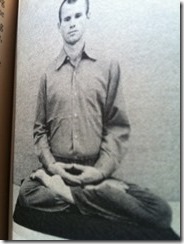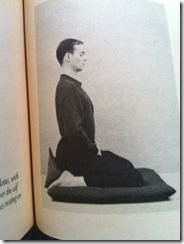The purpose of meditation
Should meditation have a purpose? If so, what should that purpose be?
Meditation as an Activity
Viewed as an ‘activity’, the activity of meditation has one purpose. It is to bring the mind and body in sync.
The main thing is to bring (collapse) the body into a single point. The Lotus posture with its legs crossed and touching the navel (just below), is one example of bringing the lower body into a single point. Combine this with the hands resting on the heels, with the thumbs touching, and you have all of the upper body also meeting at the same point as the lower body. In this PHYSICAL state, the mind has no alternative but to become focused. It may take 5 minutes , it may take 10. However, the process is guaranteed to bring about a focus of the mind.
For some people, the kneeling position (again with hands in the center – one on top of the other) – may be easier for longer duration sitting.
| Classic Yoga Lotus Position (Full Lotus). Half Lotus also accomplishes the same thing. | Japanese kneeling position |
 |
 |
Breathing Focus
Most meditative practices encourage mindful breathing. Since breathing is always in the present – bringing your attention to your breath – attempts to bring your attention (mind) to the present. While there are many breathing techniques, they are all best practiced in one of the postures above. You CAN of course, breathe consciously even on your office desk. However, for attaining full benefits of meditation, the postures above are recommended.
The Body is the Material manifestation of the mind
The Mind Body dichotomy has been discussed in detail by philosophers, scientists and mystics alike. Instead of trying to portray one as an extension of the other, Buddhism takes it one step further. The body IS the mind. There is no difference. When the mind is in a state of turmoil, the body is spread out and overly active. When the mind is at peace, the body is relaxed. The body doesn’t just reflect the state of mind , it IS the mind – just a physical embodiment of the same.
The mind is the IMMATERIAL manifestation of the body. When the body is in pain, the mind is also hurt. Not because they are somehow two different, yet connected entities. But because, they are one and the same.
Summary
Meditation is often viewed as a preparatory step – a precursor to activity. This is partly true – and certainly a composed mind will perform better at any endeavor. However, meditation itself can be viewed as an activity – one whose purpose is the unification of the mind and body.
Leave a Reply